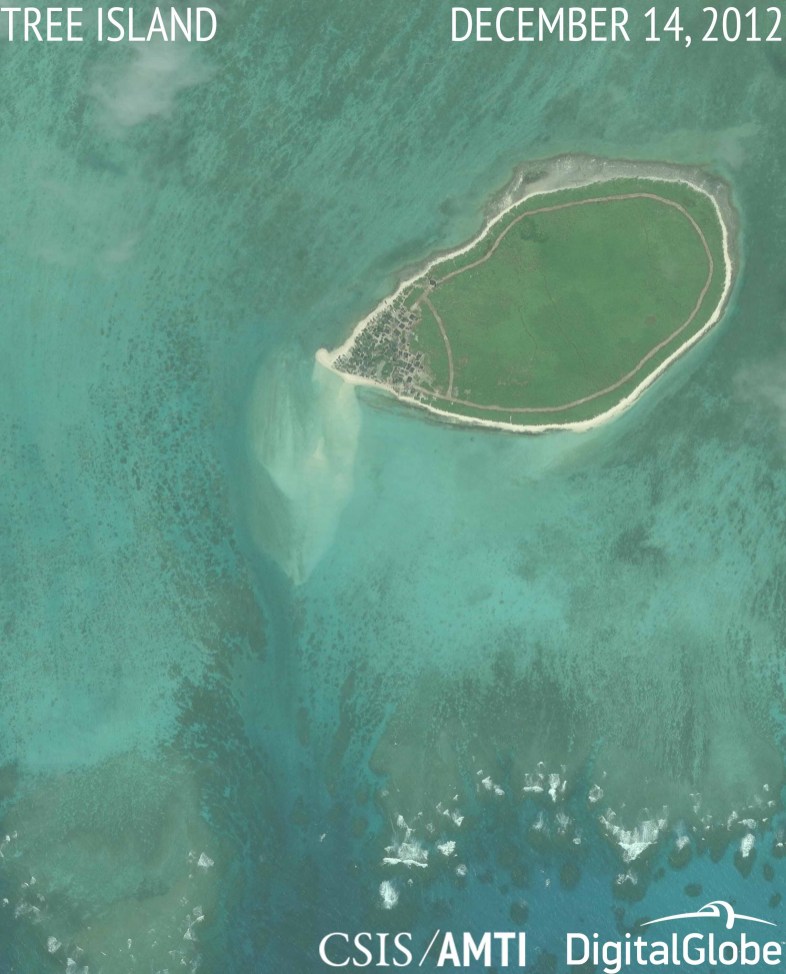Photos show China’s continued island-building in disputed waters

Photo from amti.csis.org
For a Washington-based think tank, photos do not lie.
The Asia Maritime Transparency Initiative of the Center for Strategic and International Studies (AMTI-CSIS) on Thursday disproved the claims of Chinese Foreign Minister Wang Yi and Foreign Affairs Secretary Alan Peter Cayetano that China was no longer doing reclamation work in any of the disputed islands in the South China Sea.
AMTI released satellite photos, dated August 5, showing reclamation work on Tree Island and North Island in the Paracels, which are disputed by Vietnam and China.
“AMTI has carefully documented Vietnam’s expansion of its facilities in the Spratlys, including dredging and reclamation work at several islets. But China’s own reclamation work did not end in mid-2015 with the completion of its artificial islands in the Spratlys,” the think tank said on its website.
“Beijing continues to reclaim land farther north, in the Paracel Islands. The two most recent examples of this are at Tree Island and North Island in the Amphitrite Group. AMTI previously reported on work at these features, which has continued in recent months,” it said.
“The South China Sea doesn’t only include the Spratly Islands, and for Vietnam, developments on the disputed Paracels are just as destabilizing. Vietnam and all the Southeast Asian claimants also have an interest in deterring future island-building, for instance at Scarborough Shoal,” AMTI said, adding:
“Both Beijing and Hanoi have undertaken dredging and reclamation work as recently as early 2017. Neither approaches the scale of what China did from late 2013 to mid-2015, but any such work is environmentally destructive, undermines regional stability, and warrants mention in diplomatic statements.”
Cayetano had admitted that the Philippines was among the countries that did not want to include a criticism on China’s land reclamation and militarization in the Spratlys in the recent Association of Southeast Asian Nations (Asean) foreign ministers’ statement.
“It’s not reflective of the present position. They’re not reclaiming land anymore, so why will you put it again this year?” Cayetano had said at a press conference on August 8.
At the recent 50th Asean Foreign Ministers’ Meeting and Related Meetings, held in Manila, Southeast Asian diplomats told the media that earlier drafts of the Asean statement was silent on the island building and militarization.
READ: South China Sea, North Korea tensions at Asean meet
A stronger statement was finally released on August 6, where the foreign ministers said in a joint communique that after an extensive discussion related to the South China Sea, they took note “of the concerns expressed by some Ministers on the land reclamations and activities in the area, which have eroded trust and confidence, increased tensions and may undermine peace, security and stability in the region.”
Cayetano’s statement echoed that of Wang who said China has stopped reclamation work in 2015.
The Philippines, this year’s Asean chair, has taken a softer stance on the South China Sea dispute since the Duterte administration.
It is a turnaround from the previous Aquino administration which haled China to court and won a historic arbitration decision in July last year.
READ: To stay relevant, let Asean use South China Sea arbitral ruling
AMTI said that in August 2015, China “has since dredged a new harbor and added about 25 acres of additional land” to Tree Island.
“China has recently completed a new helipad and installed renewable energy infrastructure in the form of wind turbines and two photovoltaic solar arrays on Tree Island,” AMTI added.
Satellite photos also showed that China continues its efforts to connect North Island and Middle Island in 2016.
After a typhoon washed out the bridge in October last year, China began to undertake reclamation anew on the southern end of North Island and “built a retaining wall around the seven acres of new land to prevent further erosion.”
There are also several newly-built facilities, including what AMTI noted what appears to be a large administrative building in a newly-made clearing on the island.
“China has left a gap in the retaining wall facing the remnants of the washed-out land bridge, suggesting it might not have abandoned plans to connect North and Middle Islands,” AMTI said.

Photo from amti.csis.org

Photo from amti.csis.org














